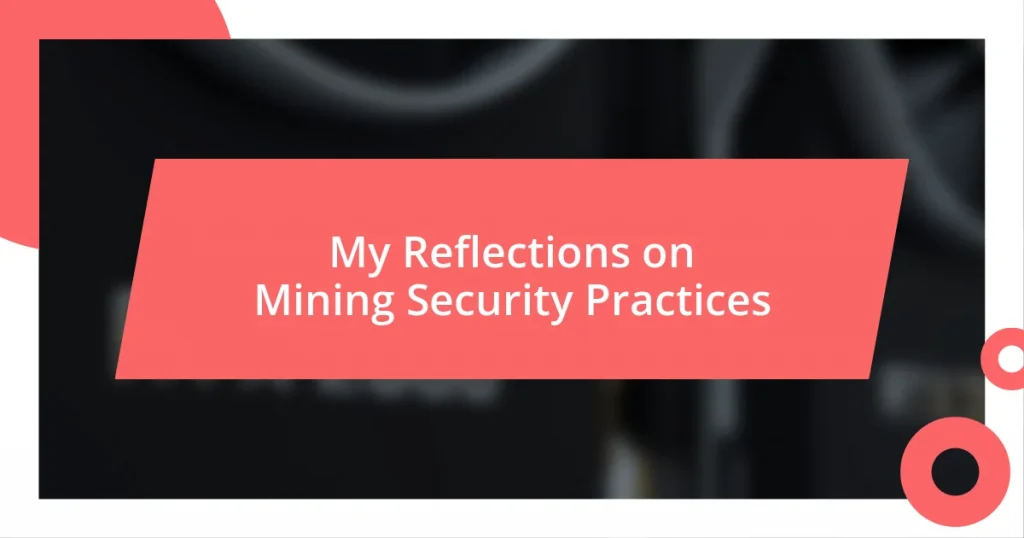Key takeaways:
- Effective mining security relies on comprehensive risk assessments, enabling proactive mitigation, resource allocation, and enhanced team cohesion.
- Implementing advanced security technologies, like surveillance drones and biometric access control, significantly increases operational safety and personnel accountability.
- Regular training, drill simulations, and open communication foster a culture of awareness and collective responsibility, crucial for incident response and overall security effectiveness.

Understanding Mining Security Challenges
Mining security challenges are multifaceted and can vary significantly depending on the location and scale of operations. I recall my early days on a mining site, where the sheer vulnerability of our equipment would keep me awake at night. It made me wonder: how often do we truly assess the risks surrounding our operations?
One of the major challenges is the increasing threat from external attacks, such as theft and sabotage. I remember a tense evening when a nearby operation faced an attempted break-in, which left everyone on edge. It’s unsettling to think that, at any moment, your investment and hard work could be jeopardized by someone seeking to exploit a gap in security.
Additionally, the internal challenges can be just as daunting. Ensuring that all employees adhere to safety protocols is crucial, yet I’ve seen complacency creep in, particularly during long shifts. How do we strike a balance between efficiency and rigorous compliance? The answer lies in continuous training and a culture of accountability, which can profoundly impact the overall security landscape in mining operations.

Importance of Risk Assessment
Risk assessment is the backbone of effective mining security practices. I remember walking through a site where we had just conducted a comprehensive risk assessment, and it felt like a weight had been lifted. Knowing we had identified potential vulnerabilities not only safeguarded our assets but also fostered a sense of security among the team. It’s fascinating how understanding the risks involved can empower everyone involved to act more responsibly, almost like a collective safety net.
Here are a few key reasons why risk assessment is so vital in our field:
- Proactive Mitigation: Identifying risks allows for preemptive measures rather than reacting to incidents after they occur.
- Resource Allocation: It helps prioritize where to allocate resources effectively, ensuring that the most vulnerable areas receive attention.
- Enhanced Compliance: Regular assessments ensure that we meet safety regulations and industry standards, reducing liability.
- Team Cohesion: Engaging the team in the assessment process fosters collaboration and builds a culture centered around safety and vigilance.
- Informed Decision-Making: It aids leadership in making informed, strategic decisions that can impact long-term operational success.
Risk assessments are more than just paperwork; they are tools that shape a culture of vigilance and responsibility on the mining site.

Implementing Security Technologies
Implementing security technologies in mining operations can significantly mitigate risks. I vividly remember the first time we introduced surveillance drones on site. The sense of heightened security was palpable, as we could monitor vast areas that were previously blind spots. With real-time video feeds, it felt like we had eyes everywhere, which not only deterred potential intruders but also fostered a sense of comfort among our team who knew they were being watched over.
In my experience, integrating technology like biometric access control systems has changed the game. I can still recall how one of our sites implemented fingerprint scanning for entry points. This system eliminated guesswork and ensured that only authorized personnel could access sensitive areas. The collective relief among staff was evident, knowing that their safety and the integrity of our operations were prioritized. It’s interesting to see how technology can create an environment where everyone feels more secure and accountable.
Of course, adopting new technologies comes with its challenges. It requires training, adjustments to existing workflows, and, often, overcoming resistance to change. I personally faced skepticism from some team members during the rollout of digital systems. However, providing consistent support and showing tangible benefits made those reservations fade. I’ve learned that even a small shift towards technology can lead to significant improvements in mining security practices.
| Technology | Benefits |
|---|---|
| Surveillance Drones | Real-time monitoring of large areas |
| Biometric Access Control | Enhanced personnel security and accountability |
| Intrusion Detection Systems | Immediate alerts for unauthorized access |
| Remote Monitoring | Access to critical data from anywhere, enhancing responsiveness |

Employee Training and Awareness
When it comes to employee training, I’ve found that the most impactful sessions are those that blend knowledge with hands-on experiences. One training I led on emergency response was a real eye-opener. Participants simulated an emergency scenario, and it was amazing to see how their confidence grew as they practiced. Don’t you think that feeling prepared can drastically affect how people react in real situations? It certainly motivated our team to stay alert and responsive.
Creating a culture of awareness around security practices isn’t just about imparting knowledge; it’s about fostering an environment where employees feel responsible for one another’s safety. I remember a particularly engaging workshop, where we broke into small groups to discuss potential security threats in our daily routines. As stories flowed, I noticed the initial hesitance transform into spirited discussions, highlighting real concerns we often overlook. It demonstrated the power of collaboration, and I couldn’t help but feel proud witnessing my colleagues take ownership of their roles in security.
Reinforcing training through regular refresher courses has proven invaluable. In my experience, I’ve witnessed how easily knowledge can fade if not revisited. I can recall a time when we held a spontaneous, unannounced security drill. Some team members nailed it, while others fell behind, which sparked a constructive discussion afterward. Isn’t it fascinating how even a little pressure can reveal strengths and weaknesses alike? By making these drills a regular part of our routine, we continue to build confidence and competency across the board, making sure that everyone is not just trained, but genuinely aware of their role in maintaining a secure environment.

Best Practices for Site Security
One of the best practices for site security involves establishing a robust perimeter defense. I recall a time when a simple yet effective addition was made: high-security fencing combined with motion sensors. The transformation was remarkable—just knowing that we had that physical barrier and immediate alerts in place genuinely reinforced the team’s sense of security. Have you ever walked onto a site and felt an immediate sense of safety? That’s how it felt, as the awareness of protection empowered us all daily.
Another critical aspect is the importance of regular security audits. In my role, I’ve often participated in these assessments, and I can tell you, they’re more than just checklists. During one audit, we uncovered vulnerabilities that we had initially overlooked, like insufficient lighting in certain areas. Realizing the need for enhancements opened my eyes to how proactive measures can mitigate risks. Isn’t it interesting how sometimes the smallest overlooked detail can have the biggest impact? Those moments make the difference in ensuring everyone feels secure.
Lastly, fostering open lines of communication cannot be understated. I’ve always encouraged my team to share any security concerns, no matter how trivial they may seem. One time, a guard alerted me about an unusual pattern he noticed in vehicle entries. It turned out to be a significant security breach in the making. This experience taught me that if people feel heard and valued, they’re more likely to participate in maintaining a secure environment. After all, isn’t it fascinating how collective vigilance can become our strongest line of defense?

Incident Response Planning
Incident Response Planning
When developing an incident response plan, I can’t stress enough the value of simulation drills. In one instance, we created a realistic threat scenario that required the entire team to act quickly. The adrenaline was palpable as we navigated the chaos, and afterwards, it struck me how such simulations not only enhance preparedness but also foster a team spirit. Have you ever felt that exhilaration when working together for a common goal? It’s incredibly unifying.
Another pivotal component of incident response planning is clearly defined roles. I once led a team through a mock incident where each member was assigned specific responsibilities. Watching them step into those roles, some naturally gravitating towards leadership, was enlightening. It’s fascinating to see how people rise to the occasion when they know what’s expected of them. Wouldn’t you agree that having a structured approach creates a sense of order in unpredictable situations?
Lastly, embracing feedback after incident response drills can’t be overlooked. After a particularly intense exercise, we gathered to review our performance together. I’ll never forget one teammate sharing how they felt during the drill—it opened my eyes to the emotional aspect of response planning. Acknowledging those feelings not only improves our future responses but also strengthens our team bond. Isn’t it remarkable how addressing emotions can lead to improvement, both individually and collectively?

Evaluating Security Measures Effectiveness
When evaluating security measures, I’ve learned firsthand that metrics play a crucial role in understanding effectiveness. During one review, we discovered that our incident reporting system only captured half of the actual security events. It struck me how vital it is to track not just the incidents but also the response times and resolutions. How can we improve if we don’t fully understand our starting point? This realization reshaped our approach to monitoring and accountability.
Another aspect that stood out to me is the importance of feedback loops in evaluating security practices. After implementing a new access control system, I created a platform for team members to share their experiences. One story from a colleague about a confusing entry process prompted us to design clearer signage, ultimately enhancing user compliance. Wouldn’t you agree that encouraging input not only empowers the staff but also leads to improved security? Engaging with the frontline team makes a world of difference—it fosters trust and collaboration.
Lastly, conducting scenario-based evaluations has proven invaluable in my experience. I remember a time we simulated a breach, and I was amazed at how different areas of our security measures responded. While some parts of our strategy shone brilliantly, others faltered, revealing gaps we could address. It’s incredible to see how realistic assessments can spark genuine improvements—could there be a better way to align our strategies with real-world challenges?















